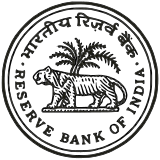
Back بنك الاحتياطي الهندي Arabic ভাৰতীয় ৰিজাৰ্ভ বেংক Assamese Bancu de la Reserva de la India AST भारतीय रिज़र्व बैंक AWA भारतीय रिजर्व बैंक Bihari ভারতীয় রিজার্ভ ব্যাঙ্ক Bengali/Bangla Rezervní banka Indie Czech Reserve Bank of India German Rezerva Banko de Barato Esperanto Banco de la Reserva de la India Spanish
 Seal of the Reserve Bank of India  Logo of the Reserve Bank of India | |
| Headquarters | Mumbai, India |
|---|---|
| Coordinates | 18°56′00″N 72°50′11″E / 18.93324°N 72.83646°E |
| Established | 1 April 1935[1] |
| Governor | Shaktikanta Das,[2] IAS (retd.) |
| Key people | Deputy Governors[3]
|
| Central bank of | |
| Currency | Indian rupee (₹) INR (ISO 4217) |
| Reserves | (as of 7 January 2024[update]) |
| Bank rate | 6.75%[5] |
| Interest on reserves | 3.35% (market determined)[5] |
| Website | rbi |
| Reserve Bank of India | |
| Agency overview | |
| Jurisdiction | Government of India |
| Key document | |
The Reserve Bank of India, abbreviated as RBI, is India's central bank and regulatory body responsible for regulation of the Indian banking system. Owned by the Ministry of Finance, Government of India, it is responsible for the control, issue and maintaining supply of the Indian rupee. It also manages the country's main payment systems and works to promote its economic development. Bharatiya Reserve Bank Note Mudran (BRBNM) is a specialised division of RBI through which it prints and mints Indian currency notes (INR) in two of its currency printing presses located in Mysore (Karnataka; Southern India) and Salboni (West Bengal; Eastern India).[6] The RBI, along with the Indian Banks' Association, established the National Payments Corporation of India to promote and regulate the payment and settlement systems in India. Deposit Insurance and Credit Guarantee Corporation was established by RBI as one of its specialized division for the purpose of providing insurance of deposits and guaranteeing of credit facilities to all Indian banks.
Until the Monetary Policy Committee was established in 2016,[7] it also had full control over monetary policy in the country.[8] It commenced its operations on 1 April 1935 in accordance with the Reserve Bank of India Act, 1934.[9] The original share capital was divided into shares of 100 each fully paid.[10] The RBI was nationalised on 1 January 1949, almost a year and a half after India's independence.[11]
The overall direction of the RBI lies with the 21-member central board of directors, composed of: the governor; four deputy governors; two finance ministry representatives (usually the Economic Affairs Secretary and the Financial Services Secretary); ten government-nominated directors; and four directors who represent local boards for Mumbai, Kolkata, Chennai, and Delhi. Each of these local boards consists of five members who represent regional interests and the interests of co-operative and indigenous banks.
It is a member bank of the Asian Clearing Union. The bank is also active in promoting financial inclusion policy and is a leading member of the Alliance for Financial Inclusion (AFI). The bank is often referred to by the name 'Mint Street'.[12]
- ^ "Reserve Bank of India – About Us". Archived from the original on 2 March 2021. Retrieved 25 February 2021.
- ^ "Shaktikanta Das is new Governor of RBI". United News of India. 11 December 2018. Archived from the original on 15 December 2018. Retrieved 11 December 2018.
- ^ "Reserve Bank of India - Deputy Governors". rbi.org.in. Archived from the original on 7 January 2024. Retrieved 7 January 2024.
- ^ "Reserve Bank of India – Weekly Statistical Supplement". Reserve Bank of India. Archived from the original on 8 June 2021. Retrieved 7 January 2024.
- ^ a b "Reserve Bank of India". rbi.org.in. Archived from the original on 14 October 2023. Retrieved 9 April 2022.
- ^ "Reserve Bank of India – About Us". www.rbi.org.in. Archived from the original on 21 April 2023. Retrieved 2 August 2022.
- ^ "All you wanted to know about Monetary Policy Committee". @businessline. 4 July 2016. Archived from the original on 6 August 2020. Retrieved 13 July 2019.
- ^ Krishnan, Aarati (4 July 2016). "All you wanted to know about Monetary Policy Committee". Business Line. Archived from the original on 6 August 2020. Retrieved 12 December 2018.
- ^ "Reserve Bank of India Act, 1934" (PDF). p. 115. Archived (PDF) from the original on 12 September 2012. Retrieved 6 August 2012.
- ^ "RESERVE BANK OF INDIA ACT, 1934 (As modified up to 27 February 2009)" (PDF). Reserve Bank of India (RBI). Archived (PDF) from the original on 21 July 2011. Retrieved 20 November 2010.
- ^ "RBI History - Brief History - RBI Nationalisation". www.rbi.org.in. Archived from the original on 6 August 2020. Retrieved 11 September 2020.
- ^ Srinivas, Yanamandra (1 December 2014). "Minsky, Monetary Policy and Mint Street: Challenges for the Art of Monetary Policymaking in Emerging Economies" (PDF). Levy Economics Institute Working Paper Collection. SSRN 2532526. Archived (PDF) from the original on 22 September 2017. Retrieved 26 December 2018.
Cite error: There are <ref group=lower-alpha> tags or {{efn}} templates on this page, but the references will not show without a {{reflist|group=lower-alpha}} template or {{notelist}} template (see the help page).
© MMXXIII Rich X Search. We shall prevail. All rights reserved. Rich X Search